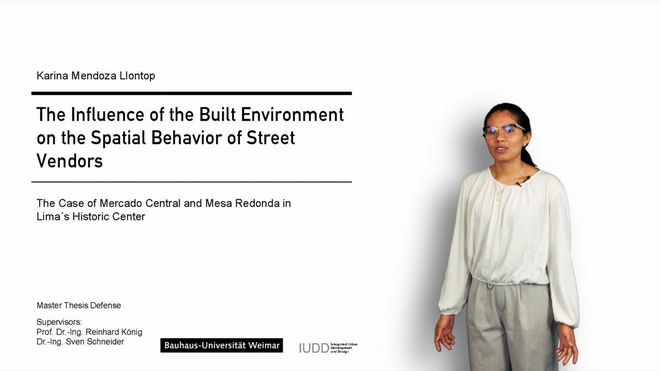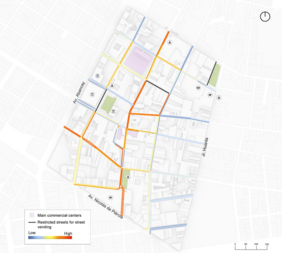Spatial Behavior of Street Vendors in Lima
Master Thesis by Karina Mendoza Llontop
Study Programme IUDD 2025
Master Thesis by Karina Mendoza Llontop
Study Programme IUDD 2025
Informality plays a crucial role in developing economies. In Peru, 70% of employment is informal, with 19% stemming from commercial activities such as street vending. While street vending significantly contributes to the economy and fosters urban social interaction, unregulated practices often lead to issues related to mobility, the environment, and safety. Authorities frequently respond with relocation strategies; however, these have often proven unsuccessful, highlighting the need for a new approach that focuses on reorganizing vendors within their existing locations. To ensure the quality of the urban environment while addressing the economic needs of street vendors, it is essential for urban planners and managers to understand the spatial behavior patterns of vendors in relation to the built environment.

Karina Mendoza Llontop - Spatial Behavior of Street Vendors in Lima (IUDD Master Thesis, 2025)
Klicken Sie auf den Play-Button, um externe Inhalte von Vimeo.com zu laden und anzuzeigen.
Externe Inhalte von Vimeo.com zukünftig automatisch laden und anzeigen (Sie können diese Einstellung jederzeit über unsere »Datenschutzerklärung« ändern.)
This thesis examines one specific case: the area of Mercado Central and Mesa Redonda in Lima’s Historic Center. In this area, the Municipality faces constant challenges in regulating the activities and spatial occupation of street vendors. The main goal is to understand which characteristics of the built environment influence the spatial distribution and occupation patterns of street vending, and how they do so. The findings aim to provide insights into vendors’ spatial behavior that should be taken into consideration when planning reorganization strategies in this area.
The research employs a mixed quantitative and qualitative methodology to analyze the relationships between selected built environment characteristics and the spatial behavior patterns of street vendors. Computational analysis is used to calculate correlations between the density and distribution of different types of vendors and built environment variables such as street functionality, density of retail entrances, pavement width, available space, and visibility. These quantitative findings are complemented by interviews with vendors and on-site observations to produce the final results.
The study reveals the strength, dynamics, and variations of the influence of selected built environment variables on the spatial behavior patterns of different types of street vending in the study area. The results offer valuable insights and recommendations for future guidelines on vendor reorganization in this part of Lima’s Historic Center.

